Video rip. Part 1-1. DVD preparation. vStrip
Content
- DVD preparation
- vStrip
- DGMPGDec
- Video processing
- What is interlace and what does it eat
- How to determine what we have: progressive, interlaced or telecined?
- Getting rid of regular interlacing (deinterlace)
- IVTC
- Squeeze and pack
What a DVD consists of
If you open the DVD, then you can find a bunch of files with strange extensions.
IFO. I n FO rmation. It contains various information for navigating a disc. Chapters, for example.
BUP. Bed and ack the UP . Backup files of the previous type.
VOB. V ideo OB jects. This type of file includes audio, video, subtitles and uninteresting overhead information. These files can be opened in a regular video player, if you have the right decoders. In case you watch DVDs on a computer, they are most likely to be with you. (and if not, then you need to put)
DVD preparation
Before starting coding, the source should be prepared. Generally speaking, you don’t need to cook, just code as it is, then cut it, but it’s not good - we’ll be a little bored and nerd. :)
The data we are interested in is mainly contained in VOB files. It’s very good if one movie takes up a whole DVD, then we can take them all (VOB files) and encode everything at once (if there is no advertising and the like), but I, for example, often have to encode TV shows, which means that in one A VOB file can be (and usually does) the end of one series and the beginning of another. Therefore, the question arises - how to properly cut this matter. If the DVD was not created by noname pirates (by the way, for the most part, they have already learned how to do everything well), then there is a chapters on the disc in which it is written how long this or that series lasts. In the end, we get the video we are interested in in one VOB file, which is very convenient.
Firstly, there is a terrible utility whose name I forgot, but, as I recall, I will definitely enter here to scare you. ( allemeine suggested that this is IFOEdit). It provides all the information you can about a DVD by analyzing VOB, IFO and other files. Now we need another program called vStrip. You can download it, for example, here . Initially, this is a command-line tool, but there is a GUI for it that makes the job a lot easier.
We select VOB files that contain the information we are interested in. In other words, we need to select the files that contain the series (or the entire movie) that we want to encode. It all depends on the manufacturer of the disk. There may be several options, but it will be difficult to describe everything, so in different specific cases you may have to break your head a little. If you know any more, then I will add them here.
First, let's see how the files on the disk are named. And they are usually called like this:
VTS_01_0.IFO
VTS_01_0.VOB
VTS_01_1.VOB
...
VTS_01_n.VOB
VTS_02_0.IFO
VTS_02_0.VOB
VTS_02_1.VOB
...
VTS_02_n.VOB
VTS_m_0.IFO
VTS_m_0.VOB
VTS_m_1.VOB
...
VTS_m_n.VOB
, where n and m are some integers.
Option 1.
Small m, usually 2 and large n. Then the VTS_01 files contain the information that we need, and in VTS_02 some kind of advertising, announcements of new disks of the manufacturer, etc.
Option 2.
Large m and not very large n. In this case, the VTS_m files contain data of interest to us, and sometimes advertising.
The second option is most liked (or loved, have not encountered for a long time) pirates. You can check what is lying with a regular video player by opening VOB files one by one. By the way, I prefer Media Player Classic .
Option 3. them. khim
In this case, the part of the video that is regularly repeated from series to series, opening and ending, for example, is stored in a separate file, due to which space is saved and we get unnecessary problems. (the original text, see the comments). In this case, this piece should be stored separately, and then, using AviSynth, connected to the main part, but more on that later. (and you can leave it like that, however, this is the business of the one who rips).
OK You have determined which group of files contains what interests you. It is time to cut it all out. Launch the vStrip GUI. Click on the Add ... button and add VOB files. Moreover, add the entire group of files. For example, you have the following list of files: VTS_02_0.VOB VTS_02_1.VOB VTS_02_2.VOB VTS_02_3.VOB

If the video you are interested in is stored in VTS_02_2, then add both VTS_02_1 and VTS_02_3 too. In the event that the file does not fit, for example, it stores video with the initial menu (why do you need to encode the menu?), Then the program will swear and suggest excluding it. That's the way she swears: This file is not worth adding, click Nein. Yes, I am also amused by the author’s reluctance to make a dialogue in English. Probably such a chip. :) I got such a picture here: Now go to the IFO tab. And open the IFO file corresponding to our VOB. If you have such a list of files: VTS_02_0.VOB VTS_02_1.VOB VTS_02_2.VOB VTS_02_3.VOB then usually the corresponding IFO will be called VTS_02_0.IFO.
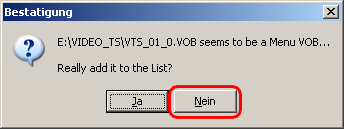


I got it like this: After the program opens the IFO file, the table of contents of the disk appears in front of you according to how the manufacturer compiled it. Compose it in completely different ways. For example, for each series, they can mark the beginning, middle and end or opening, the beginning of the series, the middle of the series, the end of the series, the ending. In general, a lot of options, so here you have to celebrate empirically. To begin, expand the table of contents tree branch: Right-click on the first leaf of the tree and click “Set Start LBA” With this action, we marked the beginning of the cut piece. You see, on each leaf of the tree there is a chapter duration:
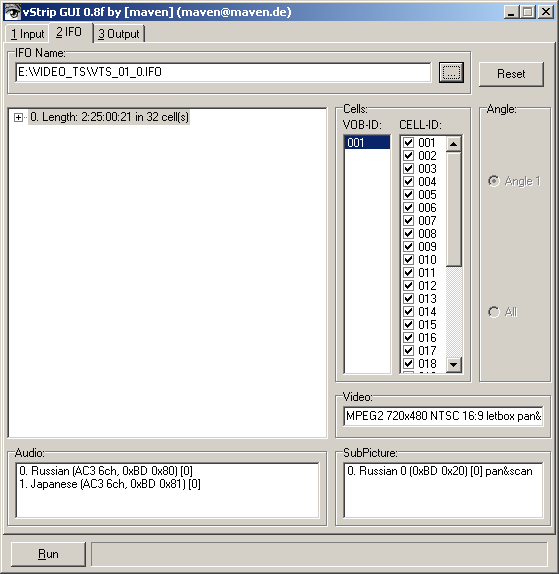
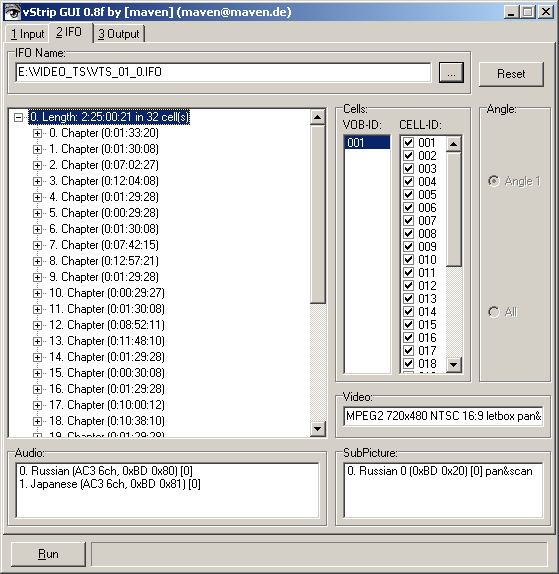

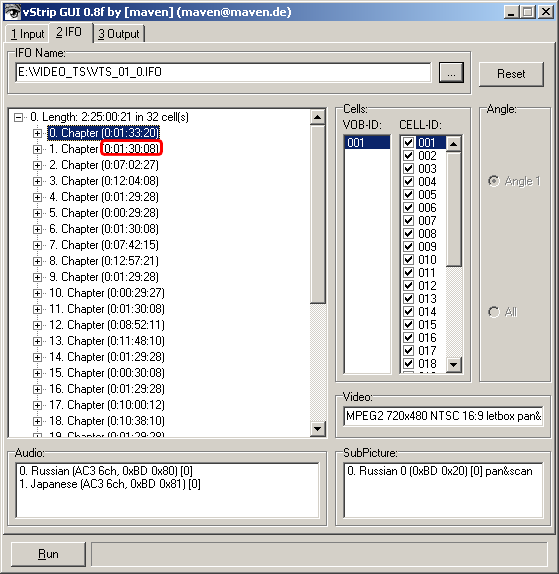
Add these durations in your mind until they add up to the duration of the series. For example, I know that in my case the length of the series is ~ 23 minutes: As soon as you decide on the chapter on which your series ends, right-click on it and select “Set End LBA”: Note: In particular, for them. khim . Sometimes it happens that the required piece takes exactly one leaf of a tree. In this case, use the last remaining menu item - “Set Start & End LBA”. Thus, only this piece is “cut out”. That's all, we marked the borders on which vStrip cuts our video. Go to the third tab “Output”, enter the name of the output file and click Run:


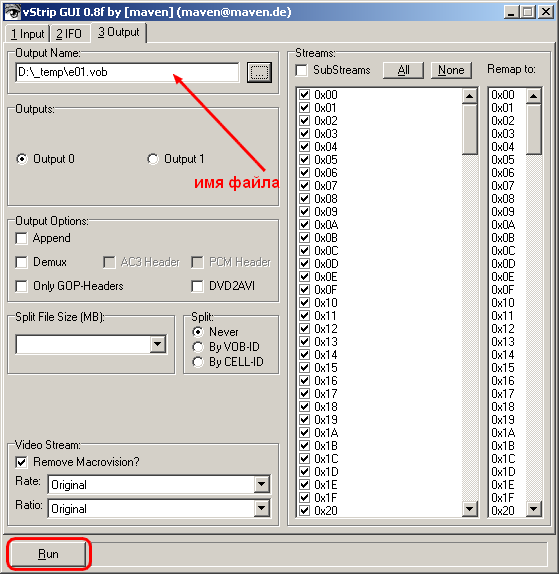
At the output, from a bunch of VOB files, you get one that contains only what we need and only what relates to a particular series. It seems to me that it is very convenient.
Note: The exception is the case of them. khim and the like. In this case, you will get a few pieces, which we will then connect using AviSynth, but this is better in any case than trying to see the boundaries of the series by eye.
In the next part, preparing the video for work in AviSynth.
